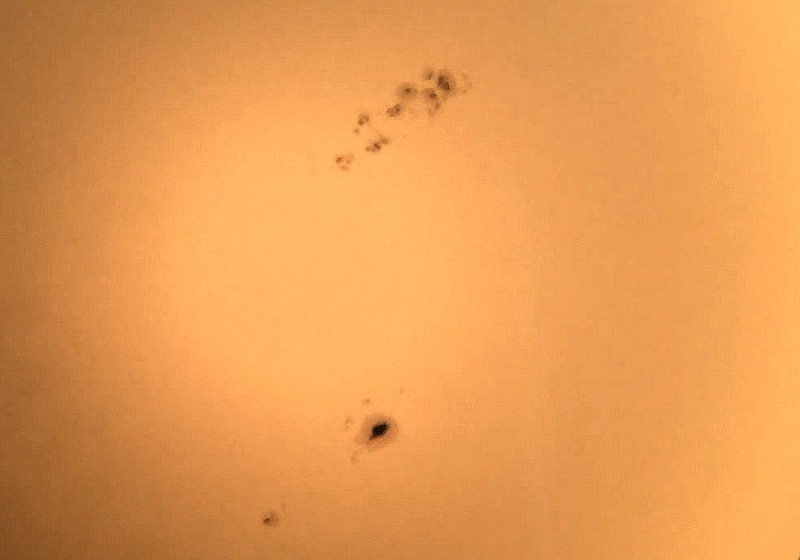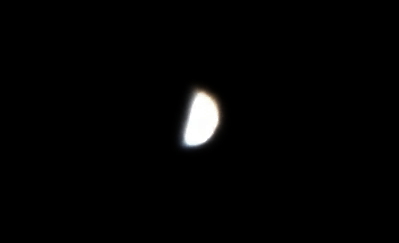
HST-Sun Transit, Venus, Neighbor Light Pollution,
Critter, Waning Gibbous Moon
Posted: 23 October 2013
Cassiopeia Observatory was opened Tuesday, 22 October 2013, at 1309 MST, 97°F. I had received an alert from CalSky.com about a transit of the sun by the Hubble Space Telescope (HST) and wanted to try to image it. The transit was to occur at 141014 MST and have a duration of 1.11 seconds. The sky was clear when I opened the observatory but there were strong breezes blowing at times.
Shortly after opening the observatory I synced the observatory clock to WWV. I then attached the Orion full-aperture solar filter to the 8" LX200-ACF. At 1326 MST, viewed the sun at 83X. Several nice sunspots were visible.
Since I planned to use the iPhone 5s and its 120 fps slo-mo video recording capability for the transit, I switched to a 1.25" 26mm eyepiece (77X). The transit would not be centered on the sun's disk so I decided that more magnification would be better. I added a 2X Barlow Lens (154X), but that was too much magnification. I then tried a 15mm eyepiece (133X) with a wider field of view as well. The view was decidedly better. I mounted the iPhone 5s on the 15mm eyepiece using my homemade iPhone afocal adapter. I used the earbuds/mic as a remote control for the iPhone camera. At 1341 MST, did a test slo-mo video recording of the sun afocal 133X. This frame (slightly cropped) shows AR1875 at the top and AR1871 at the bottom:

At 1400 MST, I re-checked the focus and camera alignment. WWV reception was lost so I would do a voiceover of the time using the observatory clock. I began slo-mo video recording at 1409 MST and continued it until 1411 MST to ensure the transit would be captured. When I reviewed the video after closing the observatory, the HST was not seen. (I have captured the HST, as well as the International Space Station, transiting the moon, and the Chinese space station Tiangong-1 transiting the sun. You can see images on the Photos: Satellites page.)
I took a quick look at the sun, 222X and 83X, at 1419 MST. The best view was at 83X; good details were visible in the AR1871 sunspot. Breezes were now stronger and I began closing up.
The observatory was closed at 1432 MST, 87°F.
Cassiopeia Observatory was re-opened on Tuesday, 22 October, at 1808 MST, 78°F. The sky was still clear. I tried to view Saturn and Mercury but both were too low into trees. Venus was still high enough to observe, 83X. At 1816 MST, switched to 133X and 267X to view Venus. I then did some iPhone 5s video recordings using my homemade iPhone adapter. I added a moon filter to the eyepiece and also used 400X for imaging. This image of Venus is cropped from a single frame of a slo-mo (120 fps) video:

I resumed Venus observing, 400X + moon filter. Nice view. At 1836 MST, Venus was into a tree so ended observing it.
At 1839 MST, viewed Alpha Capricornus, a nice wide double star, 83X. At 1846 MST, the Milky Way was nicely visible about 20 minutes before the end of Astronomical Twilight. I then viewed M30 (globular cluster), 83X. I then spent some time observing M13 (globular cluster), 222X. I also viewed M92 (globular cluster). I next viewed M57 (Ring Nebula), 222X and 133X, and M27 (Dumbbell Nebula), 133X. At 1917 MST, I slewed the 8" telescope to M74 (galaxy) to check on the supernova SN2013ej, 133X. However, it was too low in the eastern sky for good viewing. So, I slewed to M31 (Andromeda Galaxy) and viewed it at 133X. I did some exploring of its spiral arms. I also viewed its companion galaxies M32 and M110, 133X.
While I was observing M31 and its companions, the neighbor to the northeast had his bright, unshielded, floodlight on:

I had discussed the light with the neighbor a few years ago and suggested it would be more effective if it were shielded, but he said the light was for his dog (!).
While viewing M31, some strong breezes began blowing. At 1940 MST, returned to M74 and began an extended period of observing for the supernova, 133X and 83X. Supernova SN2013ej was not seen. It has definitely faded since my last observation on 6 October 2013. At 2020 MST, using averted vision, I was occasionally able to get a glimpse of what was probably the supernova, 83X. It was really difficult to see it in the 8". Since the waning gibbous moon would be rising in 15 minutes, I ended my attempts.
At 2028 MST, the eastern sky was brightening from the rising moon. At 2048 MST, I slewed the telescope to the moon, which was still behind the hill to the east. At 2108 MST, the bright floodlight went off. Thanks neighbor. Beginning at 2116 MST, I watched the moon rise over the hill, 83X. It took 2.5 minutes for the moon to rise above the hill.
As I prepared to temporarily leave the observatory to make a repair on a rubber leg tip for my observing chair, I noticed a large spider on the observatory floor. After making the repair, I returned to the observatory at 2137 MST and the spider was still there:

I then did some lunar observing at 83X. The breezes were getting stronger and more frequent. I took this handheld iPhone 5s afocal photo of the moon, 83X:

I next did a tour of the moon at 222X. While the terminator was interesting, nothing really grabbed me, so I didn't do any imaging of the terminator. The breezes had changed to wind, so I decided to close up for the night.
The observatory was closed at 2226 MST, 68°F.
Comments are welcome; use the Comments section below, or you can Email Me. Thanks.
Cassiopeia Observatory Home Page